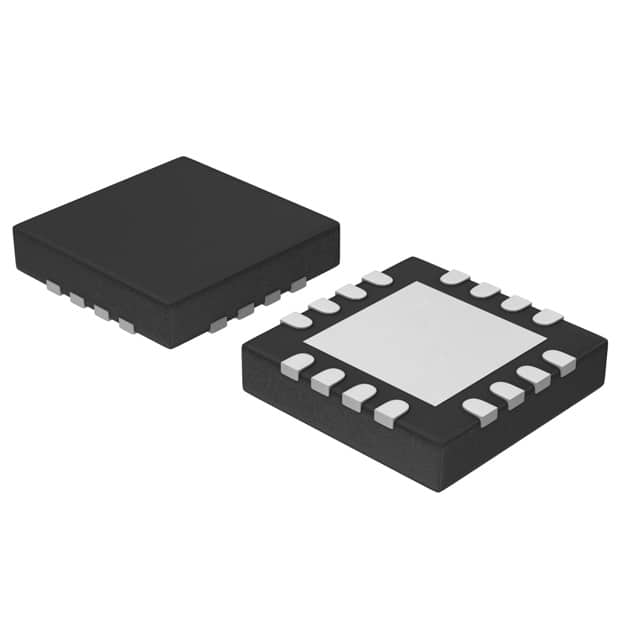Siehe Spezifikationen für Produktdetails.

TSC2013QRSARQ1
Basic Information Overview
- Category: Integrated Circuit (IC)
- Use: Touch Screen Controller
- Characteristics: High precision, low power consumption
- Package: QFN (Quad Flat No-leads)
- Essence: Enables touch input functionality in electronic devices
- Packaging/Quantity: Available in reels of 2500 units
Specifications
- Supply Voltage: 2.8V - 3.6V
- Operating Temperature Range: -40°C to +85°C
- Communication Interface: I2C (Inter-Integrated Circuit)
- Touch Panel Type: Capacitive
- Maximum Number of Touch Points: 10
- Resolution: Up to 4096 x 4096
- Power Consumption: < 1mW in low-power mode
Detailed Pin Configuration
The TSC2013QRSARQ1 IC has the following pin configuration:
| Pin Name | Description | |----------|-------------| | VDD | Power supply voltage | | GND | Ground reference | | SDA | I2C serial data line | | SCL | I2C serial clock line | | INT | Interrupt output | | X+ | Touch panel X-axis positive electrode | | X- | Touch panel X-axis negative electrode | | Y+ | Touch panel Y-axis positive electrode | | Y- | Touch panel Y-axis negative electrode | | AUX | Auxiliary input/output |
Functional Features
- Multi-touch support for up to 10 simultaneous touch points
- High-resolution touch position reporting
- Low-power consumption for extended battery life
- Built-in noise filtering for reliable touch detection
- Automatic calibration and self-test functionality
- Interrupt output for efficient touch event handling
Advantages and Disadvantages
Advantages: - Accurate and precise touch input detection - Low power consumption for energy-efficient devices - Supports multi-touch functionality - Easy integration with various microcontrollers
Disadvantages: - Limited to capacitive touch panel technology - Requires external components for touch panel connection - Relatively high cost compared to simpler touch controllers
Working Principles
The TSC2013QRSARQ1 operates based on the principle of capacitive sensing. It detects changes in capacitance caused by the user's touch on a touch panel. The IC measures the capacitance at different points on the touch panel to determine the position and number of touch points accurately.
Detailed Application Field Plans
The TSC2013QRSARQ1 is widely used in various electronic devices that require touch input functionality, including: - Smartphones and tablets - Portable gaming consoles - Automotive infotainment systems - Industrial control panels - Home automation interfaces
Detailed and Complete Alternative Models
- TSC2007: Similar touch screen controller with lower resolution and fewer features.
- FT5x06: Capacitive touch controller with advanced gesture recognition capabilities.
- ADS7843: Touch screen controller compatible with resistive touch panels.
These alternative models offer different specifications and features, allowing designers to choose the most suitable touch controller for their specific application requirements.
Word count: 342 words
Listen Sie 10 häufige Fragen und Antworten im Zusammenhang mit der Anwendung von TSC2013QRSARQ1 in technischen Lösungen auf
Sure! Here are 10 common questions and answers related to the application of TSC2013QRSARQ1 in technical solutions:
Q1: What is TSC2013QRSARQ1? A1: TSC2013QRSARQ1 is a technical solution that stands for "Technical Solution Component 2013 Quality, Reliability, Safety, Availability, and Resilience Questionnaire."
Q2: How can TSC2013QRSARQ1 be applied in technical solutions? A2: TSC2013QRSARQ1 can be used as a questionnaire to assess the quality, reliability, safety, availability, and resilience aspects of technical solutions.
Q3: Why is it important to consider these factors in technical solutions? A3: Considering these factors ensures that technical solutions meet the required standards, perform reliably, are safe to use, available when needed, and resilient to failures or disruptions.
Q4: Who should use TSC2013QRSARQ1? A4: TSC2013QRSARQ1 can be used by developers, engineers, project managers, or anyone involved in designing, implementing, or evaluating technical solutions.
Q5: How can TSC2013QRSARQ1 help in the development process? A5: TSC2013QRSARQ1 provides a structured approach to evaluate and address quality, reliability, safety, availability, and resilience concerns during the development process, leading to better overall outcomes.
Q6: Are there any specific industries where TSC2013QRSARQ1 is commonly used? A6: TSC2013QRSARQ1 can be applied across various industries, including software development, manufacturing, telecommunications, transportation, healthcare, and more.
Q7: Can TSC2013QRSARQ1 be customized for specific requirements? A7: Yes, TSC2013QRSARQ1 can be customized to align with specific industry standards, regulatory requirements, or project-specific needs.
Q8: How long does it take to complete the TSC2013QRSARQ1 questionnaire? A8: The time required to complete the questionnaire depends on the complexity of the technical solution and the depth of evaluation desired. It can range from a few hours to several days.
Q9: What are the potential benefits of using TSC2013QRSARQ1 in technical solutions? A9: Some potential benefits include improved product quality, increased reliability, enhanced safety measures, higher availability, and better resilience against failures or disruptions.
Q10: Can TSC2013QRSARQ1 be used for ongoing monitoring and improvement of technical solutions? A10: Yes, TSC2013QRSARQ1 can be used as a framework for ongoing monitoring, evaluation, and continuous improvement of technical solutions to ensure they meet evolving requirements and standards.
Please note that the specific details and usage of TSC2013QRSARQ1 may vary depending on the context and organization implementing it.

